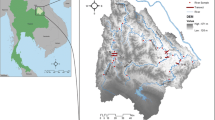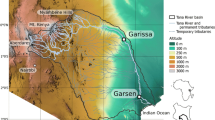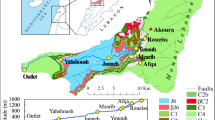Abstract
The Siak is a black water river in central Sumatra, Indonesia, which owes its brown color to dissolved organic matter (DOM) leached from surrounding, heavily disturbed peat soils. The dissolved organic carbon (DOC) concentrations measured during five expeditions in the Siak between 2004 and 2006 are among the highest reported world wide. The DOM decomposition appeared to be a main factor influencing the oxygen concentration in the Siak which showed values down to 12 μmol l−1. Results derived from a box-diffusion model indicated that in addition to the DOC concentration and the associated DOM decomposition the water-depth also plays a crucial role in regulating the oxygen levels in the river because of its impact on the turbulence in the aquatic boundary layer and the surface/volume ratio of water in the river. Model results imply furthermore that a reduced water-depth could counteract an increased oxygen consumption caused by an enhanced DOM leaching during the transition from dry to wet periods. This buffer mechanism seems to be close to its limits as indicated by sensitivity studies which showed in line with measured data that an increase of the DOC concentrations by ~15% could already lead to anoxic conditions in the Siak. This emphasizes the sensitivity of the Siak against further peat soil degradation, which is assumed to increase DOC concentrations in the rivers.












Similar content being viewed by others
Abbreviations
- A V :
-
Diffusion coefficient
- C:
-
Carbon
- C Oxygen :
-
Oxygen consumption rate
- C/O ratio:
-
Ratio between organic carbon and oxygen
- DOC:
-
Dissolved organic carbon
- DOM:
-
Dissolved organic matter
- ENSO:
-
El Niño Southern Oscillation
- F Oxygen :
-
Oxygen flux rate across the air–water interface
- k:
-
Piston velocity
- O2 :
-
Oxygen concentration
- O2sat :
-
Oxygen saturation concentration
- [O2]River :
-
Oxygen concentration in the river water
- pO2 :
-
Oxygen partial pressure
- pO2-Atmospere :
-
Partial pressure of oxygen in the atmosphere
- pO2-River :
-
Partial pressure of oxygen in the river water
- Tg:
-
Terra gram
- S Oxygen :
-
Oxygen flux through the sea surface into the surface layer
- SOI:
-
Southern Oscillation Index
- S.:
-
Sungai (river)
- u diff :
-
Diffusion velocity
- UV:
-
Ultra violet
- α:
-
Solubility coefficient of oxygen
- Δz :
-
Thickness of the layers in the model
References
Alvarez-Salgado XA, Miller AEJ (1998) Dissolved organic carbon in a large macrotidal estuary (the Humber, U.K.): behaviour during estuarine mixing. Mar Pollut Bull 37:216–224. doi:10.1016/S0025-326X(98)00156-8
Angelsen A (1995) Shifting cultivation and “deforestation”: a study from Indonesia. World Dev 23:1713–1729. doi:10.1016/0305-750X(95)00070-S
Baum A, Rixen T, Samiaji J (2007) Relevance of peat draining rivers in central Sumatra for the riverine input of dissolved organic carbon into the ocean. Estuar Coast Shelf Sci 73:563–570. doi:10.1016/j.ecss.2007.02.012
Benson BB, Krause D Jr (1984) The concentration and isotopic fractionation of oxygen dissolved in freshwater and seawater in equilibrium with the atmosphere. Limnol Oceanogr 29:620–632
Borges AV, Delille B, Schiettecatte L-S, Gazeau F, Abril G, Frankignoulle M (2004) Gas transfer velocities of CO2 in three European estuaries (Randers Fjord, Scheldt, and Thames). Limnol Oceanogr 49:1630–1641
Cameron C, Esterle JS, Palmer CA (1989) The geology, botany and chemistry of selected peat-forming environments from temperate and tropical latitudes. Int J Coal Geol 12:105–156. doi:10.1016/0166-5162(89)90049-9
Devol AH, Quay PD, Richey JE, Martinelli LA (1987) The role of gas exchange in the inorganic carbon, oxygen, and 222Rn budgets of the Amazon River. Limnol Oceanogr 32:235–248
Diaz RJ (2001) Overview of hypoxia around the world. J Environ Qual 30:275–281
DWD (2006) Monthly precipitation (monitoring) product (1.0° gridcells). Global Precipitation Climatology Centre, Deutscher Wetterdienst, Offenbach am Main
FAO (2003) Soil map of the world. (p 1:5000000). FAO/UNESCO, Rome
Freeman C, Evans CD, Monteith DT, Reynolds B, Fenner N (2001) Export of organic carbon from peat soils. Nature 412:785. doi:10.1038/35090628
Freeman C, Fenner N, Ostle NJ, Kang H, Dowrick DJ, Reynolds B et al (2004) Export of dissolved organic carbon from peatlands under elevated carbon dioxide levels. Nature 430:195–198. doi:10.1038/nature02707
Guerin F, Abril G, Serca D, Delon C, Richard S, Delmas R et al (2007) Gas transfer velocities of CO2 and CH4 in a tropical reservoir and its river downstream. J Mar Syst 66:161–172. doi:10.1016/j.jmarsys.2006.03.019
Hamilton SK, Sippel SJ, Calheiros DF, Melack JM (1997) An anoxic event and other biogeochemical effects of the Pantanal wetland on the Paraguay River. Limnol Oceanogr 42:257–272
Harrison JA, Caraco N, Seitzinger S (2005) Global patterns and sources of dissolved organic matter export to the coastal zone: Results from a spatially explicit, global model. Global Biogeochem Cycles 19:GB4S04. doi:10.1029/2005GB002480
Holden J (2005) Peat land hydrology and carbon release: why small-scale process matters. Philos Trans R Soc 363:2891–2913. doi:10.1098/rsta.2005.1671
Holden J, Chapman PJ, Labadz JC (2004) Artificial drainage of peat lands: hydrological and hydrochemical process and wetland restoration. Prog Phys Geogr 28:95–123. doi:10.1191/0309133304pp403ra
Hooijer A, Silvius M, Wösten H, Page SE (2006) Peat-CO2, assessment of CO2 emissions from drained peat lands in SE Asia. Delft Hydraulic report Q3943. WL Delft Hydraulics, Delft, p 36
Hope D, Billett MF, Cresser MS (1994) A review of the export of carbon in river water: fluxes and processes. Environ Pollut 84:301–324. doi:10.1016/0269-7491(94)90142-2
Howitt JA, Baldwin DS, Rees GN, Williams JL (2007) Modeling black water: predicting water quality during flooding of lowland river forests. Ecol Modell 203:229–242. doi:10.1016/j.ecolmodel.2006.11.017
Jahnke RA (1996) The global ocean flux of particulate organic carbon: areal distribution and magnitude. Global Biogeochem Cycles 10:71–88. doi:10.1029/95GB03525
Kremer J, Reischauer A, D’Avanzo C (2003) Estuary-specific variation in the air-water gas exchange coefficient for oxygen. Estuaries Coasts 26:829–836
Laumonier Y (1997) The vegetation and physiography of Sumatra. Kluwer Academic Publishers, Dordrecht
Mantoura RFC, Woodward EMS (1983) Conservative behavior of riverine dissolved organic carbon in the Severn Estuary: chemical and geochemical implications. Geochim Cosmochim Acta 47:1293–1309
Marland G, Boden T, Andres RJ (2007) National CO2 emissions from fossil-fuel burning, cement manufacture, and gas flaring: 1751–2004. Oak Ridge National Laboratory Oak Ridge, Tennessee 37831–6335
Miller AEJ (1999) Seasonal investigations of dissolved organic carbon dynamics in the Tamar Estuary, U.K. Estuar Coast Shelf Sci 49:891–908. doi:10.1006/ecss.1999.0552
Naqvi SWA, Jayakumar DA, Narvekar PV, Naik H, Sarma VVSS, D’Souza W et al (2000) Increased marine production of N2O due to intensifying anoxia on the Indian continental shelf. Nature 408:346–349. doi:10.1038/35042551
Paerl HW (2006) Assessing and managing nutrient-enhanced eutrophication in estuarine and coastal waters: Interactive effects of human and climatic perturbations. Ecol Eng 26:40–54. doi:10.1016/j.ecoleng.2005.09.006
Rabalais NN (1999) Changes in Mississippi river nutrient fluxes and consequences for the northern Gulf of Mexico coastal ecosystem. LOIZ Newsl 13:1–3
Raymond PA, Cole JJ (2001) Gas exchange in rivers and estuaries: choosing a gas transfer velocity. Estuaries 24:312–317. doi:10.2307/1352954
Rieley JO, Ahmad-Shah AA, Brady MA (1996) The extent and nature of tropical peat swamps. In: Maltby E, Immirzi CP, Safford RJ (eds) Tropical lowland peatlands of Southeast Asia. IUCN, Gland, pp 17–53
Ropelewski CF, Halpert MS (1987) Global and regional scale precipitation patterns associated with El Nino/Southern Oscillation. Mon Weather Rev 115:1606–1626. doi :10.1175/1520-0493(1987)115<1606:GARSPP>2.0.CO;2
Sorensen KW (1993) Indonesian peat swamp forests and their role as a carbon sink. Chemosphere 27:1065–1082. doi:10.1016/0045-6535(93)90068-G
Turner RE, Rabalais NN (1994) Coastal eutrophication near the Mississippi river delta. Nature 368:619–621. doi:10.1038/368619a0
Acknowledgments
We would like to thank all scientists and students from the University of Pekanbaru who helped us during our field work, the rector of the University of Riau, the captain of the research vessel R/V Senangin and his crew for their support. For helpful discussion we would like to thank the anonymous reviewer, V. Ittekkot, P. Damm our colleagues from the ZMT and Rena Kerr. We are also grateful to the Federal German Ministry for Education, Science, Research and Technology (BMBF, Bonn grant number 03F0392C-ZMT) for financial support and to R. Schlitzer as well as to P. Wessels and W.·H. F. Smith for providing Ocean Data View (ODV) and the generic mapping tools (GMT).
Author information
Authors and Affiliations
Corresponding author
Rights and permissions
About this article
Cite this article
Rixen, T., Baum, A., Pohlmann, T. et al. The Siak, a tropical black water river in central Sumatra on the verge of anoxia. Biogeochemistry 90, 129–140 (2008). https://doi.org/10.1007/s10533-008-9239-y
Received:
Accepted:
Published:
Issue Date:
DOI: https://doi.org/10.1007/s10533-008-9239-y




